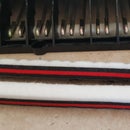Introduction: DIY Low Cost Hot Wire Plastic Sheet Bending Tool
In this instructable, you will find information on how to build your own "hot wire plastic sheet bending tool" (thermoplieuse in french):
- theory (some)
- shopping list
- electrical design (power supply)
- mechanical design (tension spring, insulation)
- list of suitable plastics
- issues and solutions
- links to other tutorials
it's not about hot wire foam cutting... https://www.instructables.com/id/Hot-wire-foam-cut...
Step 1: Some Theory
How does it work?
http://www.bristolite.com/Interfaces/thermoform.as...
All thermoplastics go through two distinct phases as they are heated.
- ‘elastic’; the material is springy
- As the material is heated further though, it will become ‘plastic’: the material is soft and malleable, like dough, and can easily be formed.
The temperatures at which TP’s become elastic or plastic depend on the material type.
What is the best plastic?
Some TP’s have a large temperature range during which they are either elastic or plastic. This is useful for thermoforming like line bending.
Step 2: Design
Safety first:
- Electricity
As the wire is not electrically insulated, I don't want any voltage above 12V or 24V.
NO 230V - Thermal issues:
You have to protect your tool from excessive heat.
Use aluminium sheets or recycle the inner insulation of the toaster or hair-dryer!
Some have designed "water cooled" system. It's not mandatory and expensive.A kit for personal computer water cooling is 80€.
Step 3: Shopping List
1 wooden plank
40cm x 80cm 10mm th
2 Hinges
1 traction spring
Heating element:
you can find some Nichrome wire sellers
- from Aliexpress or eBay
32 AWG Ø0.2m 10 meter roll on aliexpress 3€50
30 AWG Ø0.25mm
26 AWG Ø0.4mm
24 AWG Ø0.5mm
but I recommand you to recycle for free an old and broken device, such as
- a toaster
- a hair dryer: mine is from a 1000W hair dryer. I got around 4 meters of Ø0.5mm wire
keep the insulated sheets!
Power Supply:
@12V, the wire goes red in the dark. Ammeter says 2.5 A
You can recycle a laptop computer power supply (from 12V to 18V or 24V).
Step 4: Hair Dryer Nichrome Wire
You just have to cut a 50cm wire length
and unbend it manually.
Step 5: Building the Board
For a lighter weight, I didn't sandwich 2 planks like others tutorial (it's useless and heavier)
Instead, I have cut some wedges:
2 thin wedges for the ends
1 larger for the middle and cut into 2 pieces to broaden to 50cm in order to fix the heating wire and spring.
Step 6: U Bar and Hinge
I place
Step 7:
Be careful to center the wire in the middle of the U
Be careful to level the wire just below the surface: it should never touch directly the plastic sheet!
Step 8: How to Bend
for 3mm thick sheet, I needed 90 sec to heat it
if you want to prevent some parts from being heated:
- use a wet fabric
- use the insulation sheet materiel you found in the hair drier: it's very efficient!
Step 9: Design
Power supply design
Ohm law / Power
http://www.markssupplies.com/what-size-nichrome-wire-to-use.html
the current will be calculated in order to reach the needed temperature
let's have a look on the plastic specification: what are the plastic range temperatures?
Mechanical design:
distance from plastic surface
The wire should be very close to the plastic sheet BUT not touching it!
Be sure to design a mount that ensure that.
tension
Warning: wire will elongate when heated up.
In order to keep a constant tension on it, use a spring at one end.
You may want to have an adjustment of the width around the heating wire
Step 10: Plastic Sheets Selection
List of thermoplastics:
Like PC,
cast and extruded PMMA,
PVC,
PETG,
ABS,
PS,
HDPE
and PP .
http://www.crclarke.co.uk/Products/PDF/data/1plast...
Polycarbonate sheets are softened along a narrow
line by a strip heater, usually a hot wire. When the shaping temperature is reached, not below 155°C (maximum temperature 167°C)
Step 11: Issues
Bubbles: All plastics absorb moisture to varying degrees. When a thermoplastic is heated, internal moisture turns into steam and expand in bubbles.
In plastics that have mostly elastic windows, this has no effect, as the tensility of the material resists the pressure of the steam bubbles. However in plastics that have mostly plastic windows, the steam causes the moisture bubbles to expand and where the bubbles are near the surface they may burst, forming blisters, ruining the surface quality of the sheet.
Hygroscopic TP need pre-drying.
Ends overheating:
The ends of a bend line can receive more heat because the edge gets heated as well as the surface.
Some TP’s may need ‘shielding’ with pieces of scrap material at either end of the bend line, to prevent overheating and damage the ends of the bend.
Step 12: Another Example
You can even thermoform the box around the components in order to achieve a compact design :-)













